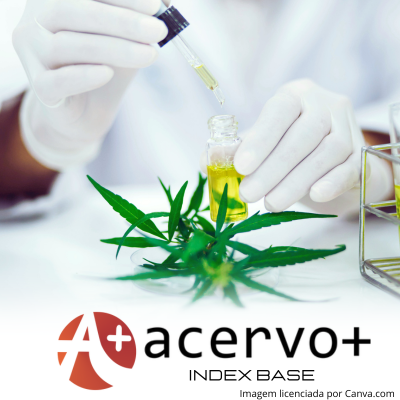Atividade antimicrobiana do óleo de cannabis sativa
##plugins.themes.bootstrap3.article.main##
Resumo
Objetivo: Avaliar a atividade antimicrobiana do óleo de cannabis (Cannabis sativa), destacando compostos como canabinoides e terpenos, e sua eficácia contra patógenos. A análise compara-o com outros óleos essenciais, como óleo de tea tree e óleo de Mentha piperita, e explora sua origem e processo de extração. Revisão bibliográfica: A resistência crescente aos antibióticos impulsiona a busca por alternativas terapêuticas, com óleos essenciais emergindo como opções viáveis devido às suas propriedades antimicrobianas. O óleo de cannabis destaca-se por seu perfil único, eficaz contra bactérias Gram-positivas, Gram-negativas e fungos. Comparado ao óleo de tea tree e ao de Mentha piperita, o óleo de cannabis oferece um espectro antimicrobiano diferenciado e múltiplos mecanismos de ação. O estudo também analisa a origem do óleo de cannabis e os avanços em seus métodos de extração, especialmente a extração por CO2 supercrítico. Considerações finais: O óleo de cannabis mostra potencial no combate a patógenos resistentes, com características antimicrobianas distintas em relação a outros óleos essenciais. No entanto, mais pesquisas são necessárias para confirmar sua inocuidade e eficácia clínica, incluindo ensaios clínicos e estudos sobre dosagem e interações medicamentosas.
##plugins.themes.bootstrap3.article.details##
Copyright © | Todos os direitos reservados.
A revista detém os direitos autorais exclusivos de publicação deste artigo nos termos da lei 9610/98.
Reprodução parcial
É livre o uso de partes do texto, figuras e questionário do artigo, sendo obrigatória a citação dos autores e revista.
Reprodução total
É expressamente proibida, devendo ser autorizada pela revista.
Referências
2. BAKKALI F, et al. Biological effects of essential oils - A review. Food and Chemical Toxicology, 2008; 46(2): 446–475.
3. BERMAN P e KLOOG Y. Cannabis and Cancer: Reality or Pipe Dream? Cannabis Therapeutics, 2018; 10(4): 293–305.
4. BITENCOURT R, et al. Antibacterial and antifungal properties of Cannabis terpenes: a review of the pharmacological literature. International Journal of Molecular Sciences, 2020; 21(6): 4781.
5. CARSON C, et al. Melaleuca alternifolia (Tea Tree) Oil: a Review of Antimicrobial and Other Medicinal Properties. Clinical Microbiology Reviews, 2006; 19(1): 50–62.
6. CARTER B, et al. Supercritical CO₂ extraction of bioactive compounds. Journal of Supercritical Fluids, 2018; 133: 346–353.
7. CAVANAGH HM e WILKINSON JM. Biological activities of lavender essential oil. Phytotherapy Research, 2002; 16(4): 301–308.
8. COX S, et al. The mode of antimicrobial action of the essential oil of Melaleuca alternifolia (Tea Tree Oil). Journal of Applied Microbiology, 2001; 88(1): 170–175.
9. DELAQUIS PJ, et al. Antimicrobial properties of essential oils: Journal of Food Protection, 2002; 65(2): 208–213.
10. DEVANE WA, et al. Isolation and structure of a brain constituent that binds to the cannabinoid receptor. Science, 1992; 258(5090): 1946–1949.
11. ELSOHLY MA e SLADE D. Chemical constituents of marijuana: The complex mixture of natural cannabinoids. Life Sciences, 2005; 78(5): 539–548.
12. EYER P, et al. Antimicrobial properties of cannabidiol and its interaction with antibiotics. Frontiers in Microbiology, 2017; 8: 2595.
13. HAMMER KA, et al. Antimicrobial activity of essential oils and other plant extracts. Journal of Applied Microbiology, 1999; 86(6): 985–990.
14. HEMP W. The Rise of CBD: Market trends and therapeutic potential. Journal of Alternative and Complementary Medicine, 2022; 28(1): 100–113.
15. KOGAN NM e MECHOULAM R. Cannabinoids in health and disease. Dialogues in Clinical Neuroscience, 2007; 9(4): 413–430.
16. KOGAN NM e MINDA M. Antimicrobial efficacy of cannabinoids: emerging therapeutic applications. Journal of Infection and Public Health, 2006; 3(1): 76–82.
17. MECHOULAM R e GAONI Y. A total synthesis of Δ1-tetrahydrocannabinol, the active constituent of hashish. Journal of the American Chemical Society, 1965; 87(14): 3273–3275.
18. MECHOULAM R e SHVO Y. Hashish—I: The structure of cannabidiol. Tetrahedron, 1963; 19(12): 2073–2078.
19. MILLER H, et al. Cannabis extraction methods: A review. Journal of Natural Products, 2020; 83(5): 1418–1430.
20. MUDGE E, et al. The science behind cannabis extraction methods. Cannabis Science and Technology, 2000; 2(3): 25–35.
21. NAKAYAMA T, et al. Antimicrobial activity of peppermint oil: a study in vitro. Journal of Medical Microbiology, 2018; 67(4): 581–585.
22. OLIVEIRA AC, et al. Antifungal properties of Cannabis sativa and its potential therapeutic use. Journal of Medicinal Plants Research, 2021; 15(5): 245–255.
23. PARKER TA, et al. Cannabidiol as a potential therapeutic for antibiotic-resistant bacteria. British Journal of Pharmacology, 2019; 176(10): 1947–1958.
24. PERTWEE RG. The diverse CB1 and CB2 receptor pharmacology of three plant cannabinoids: Δ9-tetrahydrocannabinol, cannabidiol, and Δ9-tetrahydrocannabivarin. British Journal of Pharmacology, 2008; 153(2): 199–215.
25. PRATT S, et al. The antimicrobial effect of essential oils: A critical review. Journal of Essential Oil Research, 2011; 23(5): 42–50.
26. RINALDI M, et al. The role of CBD in microbial resistance: Mechanistic insights. Infection and Drug Resistance, 2018; 11: 117–125.
27. RUSSO EB. History of Cannabis and Its Preparations in Saga, Science, and Sobriquet. Chemistry & Biodiversity, 2007; 4(8): 1614–1648.
28. RUSSO EB. Taming THC: potential cannabis synergy and phytocannabinoid-terpenoid entourage effects. British Journal of Pharmacology, 2011; 163(7): 1344–1364.
29. SCANDURRA L, et al. Cannabinoid effects on bacterial membranes and implications for antimicrobial efficacy. Journal of Natural Products, 2015; 78(10): 2402–2408.
30. VIUDEZ M, et al. Synergistic effects of terpenes and cannabinoids against pathogenic bacteria. European Journal of Clinical Microbiology & Infectious Diseases, 2016; 35(3): 441–448.
31. WHO (World Health Organization). Global Action Plan on Antimicrobial Resistance. WHO Publications, 2021.
32. ZIEMIŃSKA E, et al. The antifungal effect of Cannabis sativa against clinically relevant fungi. Mycopathologia, 2019; 184(2): 283–294.
33. ZOU X, et al. Cold-pressing extraction of cannabis oil. Food Chemistry, 2018; 262: 241–249.
34. ZUARDI AW, et al. Cannabidiol for the treatment of psychosis in Parkinson's disease. Journal of Psychopharmacology, 2013; 27(11): 1088–1098.

